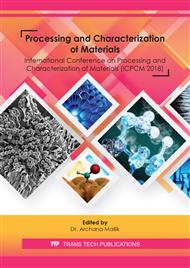p.311
p.316
p.323
p.330
p.337
p.344
p.353
p.360
p.369
Predicting Effective Electromechanical Properties of Pb-Free Polymer Composite Using Finite Element Method
Abstract:
Polyvinylidene fluoride (PVDF) – Lead Zirconate Titanate (PZT) is a polymer composite that is becoming increasingly popular in micro-scale sensors and actuators because of its unique properties such as high flexibility, low density and high piezoelectric constants. However, lead-based piezoceramics, despite their superior properties, are toxic and are known to damage the environment, and as such a conscientious effort is being made by the scientific community towards replacing lead-containing piezoceramics with environmentally-friendlier and lead-free piezoceramics. Barium Titanate (BaTiO3) is one such piezoceramics that is widely studied today to be a potential replacement of PZT in many applications. As such, in this work, effort has been made to predict the effective mechanical, dielectric and piezoelectric properties of PVDF-BaTiO3 composite system using Finite Element Method (FEM). Kinematic Uniform Boundary Conditions (Displacement and Voltage) are used for this analysis. For evaluation of the effective material constants of the composite, several types of representative volume elements are considered. The effects of volume fraction, effect of the size of the micro-particles i.e. mono-modal versus multi-modal size distribution, effect of periodic versus quasi-random distribution of microparticles in the matrix, the effect of clustering of the particles, effect of orientation of the microparticles i.e. unidirectional or randomly oriented are discussed. Finally, a comparison of properties between PVDF-PZT and PVDF-BaTiO3 is made, so as to see whether PVDF-BaTiO3 can be a potential replacement for PVDF-PZT composite.
Info:
Periodical:
Pages:
337-343
Citation:
Online since:
February 2020
Authors:
Price:
Сopyright:
© 2020 Trans Tech Publications Ltd. All Rights Reserved
Share:
Citation:


